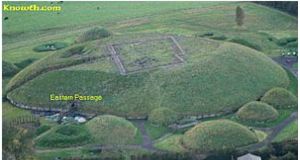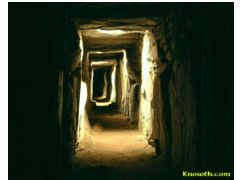
A brief
introduction to interesting aspects of one of Ireland's
premier heritage attractions
 The Great
Mound at Knowth is similar in scale to Newgrange and is
surrounded by 18 smaller satellite tombs. The aerial view
below, photographed last year, shows the construction work
at the entrance to the Eastern Passage which is now
complete. The site is now fully open to the public but,
unlike Newgrange, visitors are not allowed down the 40 metre
Eastern Passage. The metal bridge takes visitors to a room
constructed just inside the mound, the passage which is
closed off by a gate can be viewed as shown in the following
image. The Great
Mound at Knowth is similar in scale to Newgrange and is
surrounded by 18 smaller satellite tombs. The aerial view
below, photographed last year, shows the construction work
at the entrance to the Eastern Passage which is now
complete. The site is now fully open to the public but,
unlike Newgrange, visitors are not allowed down the 40 metre
Eastern Passage. The metal bridge takes visitors to a room
constructed just inside the mound, the passage which is
closed off by a gate can be viewed as shown in the following
image.
|

|
 There
is no public access to the 34 metre Western Passage, which
runs almost in a straight line with the Eastern Passage, the
chambers of the two passages are only a few metres apart.
The tombs face due east and due west so there is probably a
connection with the rising and setting sun at the equinoxes
which occur around the 21st March and the 21st of September
each year. While Knowth doesn't have a proven astronomical
alignment, such as the illumination of the passage and
chamber by the winter solstice sun at Newgrange, it has
significantly more megalithic art than Newgrange. To quote
from George Eogan's book "Knowth and the passage-tombs of
Ireland" There
is no public access to the 34 metre Western Passage, which
runs almost in a straight line with the Eastern Passage, the
chambers of the two passages are only a few metres apart.
The tombs face due east and due west so there is probably a
connection with the rising and setting sun at the equinoxes
which occur around the 21st March and the 21st of September
each year. While Knowth doesn't have a proven astronomical
alignment, such as the illumination of the passage and
chamber by the winter solstice sun at Newgrange, it has
significantly more megalithic art than Newgrange. To quote
from George Eogan's book "Knowth and the passage-tombs of
Ireland"
|

|
 Knowth
has more than a quarter of the known megalithic art from all
other areas of Europe, including Ireland. Knowth has about
45% of the total of known megalithic art from all Irish
passage-tombs.Knowth exceeds by about 100 the total number
of decorated stones from the other Brugh na Bóinne
tombs. Mythical Ireland by Anthony Murphy is a good site to
view the Megalithic Art at Knowth. The site has about 60
photographs of the art on Knowth kerbstones, most of the
decorated stones are included. Knowth
has more than a quarter of the known megalithic art from all
other areas of Europe, including Ireland. Knowth has about
45% of the total of known megalithic art from all Irish
passage-tombs.Knowth exceeds by about 100 the total number
of decorated stones from the other Brugh na Bóinne
tombs. Mythical Ireland by Anthony Murphy is a good site to
view the Megalithic Art at Knowth. The site has about 60
photographs of the art on Knowth kerbstones, most of the
decorated stones are included.
Knowth Timelines (based on Tour
Guide notes by Bryn Coldrick).
 The
Passage Tombs at Knowth were constructed about 5000 years
ago in the Neolithic, or New Stone Age, period. The
Passage Tombs at Knowth were constructed about 5000 years
ago in the Neolithic, or New Stone Age, period.
 A
Bronze Age burial was discovered at Knowth. It had a Beaker
pot next to some cremated human remains. The early Bronze
Age people were known as the ‘Beaker People’
because of the style of pottery they used. A
Bronze Age burial was discovered at Knowth. It had a Beaker
pot next to some cremated human remains. The early Bronze
Age people were known as the ‘Beaker People’
because of the style of pottery they used.
 In
the Iron Age, over 3,000 years after the tombs were built, a
settlement was constructed at Knowth and an enclosure was
built on top of the great mound. The house within this
enclusure was protected by two concentric ditches and banks
which were dug into the main mound. These ditches shortened
the passages leading into the tombs by 4 metres and
destroyed the original entrances. In
the Iron Age, over 3,000 years after the tombs were built, a
settlement was constructed at Knowth and an enclosure was
built on top of the great mound. The house within this
enclusure was protected by two concentric ditches and banks
which were dug into the main mound. These ditches shortened
the passages leading into the tombs by 4 metres and
destroyed the original entrances.
 In
the early medieval period, between the 8th and 12th
centuries AD. Knowth was the capital of one of
Ireland’s many Kingdoms, that of North Brega. The
people who lived at Knowth during this period built
rectangular houses with stone foundations and souterrains,
or underground passages, which they probably used for
storage and refuge. In
the early medieval period, between the 8th and 12th
centuries AD. Knowth was the capital of one of
Ireland’s many Kingdoms, that of North Brega. The
people who lived at Knowth during this period built
rectangular houses with stone foundations and souterrains,
or underground passages, which they probably used for
storage and refuge.
 Following
the Anglo-Norman invasion from Britain, the armies reached
Knowth in 1175 and used it as a military base for their
conquest of Meath. Following
the Anglo-Norman invasion from Britain, the armies reached
Knowth in 1175 and used it as a military base for their
conquest of Meath.
 © Michael Fox MMII
© Michael Fox MMII
About the
Author
Michael Fox runs the website
Knowth.com
|



